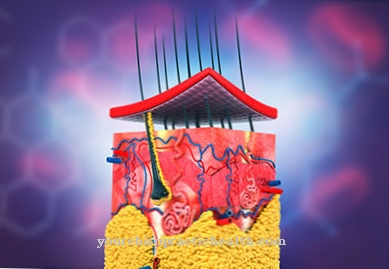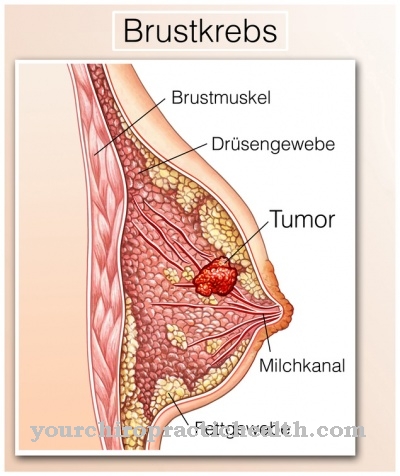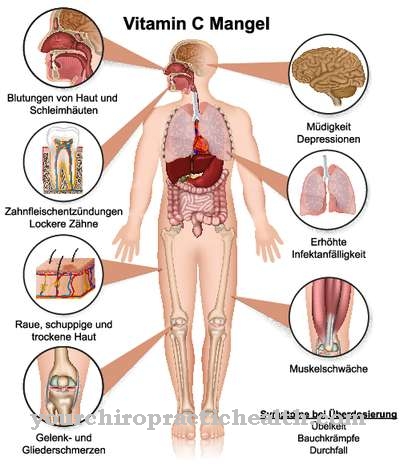ankylosing spondylitis, which are also called Ankylosing spondylitis or bechterew's disease known is a rheumatic disease with a chronic course. Bechterew's disease mostly affects the joints, especially the spinal joints.
What is Bechterew's disease?

© Alila Medical Media - stock.adobe.com
ankylosing spondylitis or Ankylosing spondylitis and bechterew's disease called, is a chronic inflammatory rheumatic disease that mainly affects the joints.
Above all, the spinal joints are affected, which increasingly stiffen as the disease progresses.
In addition, inflammatory changes occur in the tendons, eyes, large joints and the heart muscle, as there are no rheumatoid factors in the blood. Internal organs are rarely affected.
causes
The cause of ankylosing spondylitis is a disturbed interplay between environmental influences and genetic makeup. The hereditary trait HLA-B27 is found in around 95 percent of those affected, which leads to a faulty immune reaction and thus promotes the development of chronic inflammation.
This hereditary trait indicates that the cause of the disease is partly hereditary. In addition, the hereditary trait HLA-B27 can cause the human immune system to deal with the normal germs in the intestinal flora in such a way that this also leads to chronic inflammation.
Symptoms, ailments & signs
The main symptoms of ankylosing spondylitis are deep back pain, morning stiffness, and nighttime pain. If these symptoms persist for at least three months, it is an unmistakable sign that ankylosing spondylitis is present. During the day, the body becomes more flexible again. Symptoms improve, especially with exercise.
In contrast, when the patient is at rest, the pain and stiffness increase again. The pain is mostly in the lower part of the spine and radiates into the buttocks and thighs. Early signs of ankylosing spondylitis can be such uncharacteristic symptoms as occasional heel, hip, knee or shoulder pain.
In addition, fatigue, pain when sneezing or coughing and weight loss can occur in the early stages. Bursitis and other tendon diseases are also possible. Bechterew's disease occurs in episodes. The patient is almost symptom-free between attacks. The posture of those affected typically changes over time due to the curvature of the thoracic spine (humpbacks) and simultaneous flattening of the lumbar spine.
Over time, the hip and knee joints as well as the shoulders and elbows can be affected by painful restrictions on movement. A smaller proportion of patients develop arrhythmias, impaired vision, or kidney failure. Inflammation of the main artery or other cardiovascular diseases are less common. It is also suspected that some intestinal or urinary tract infections are related to ankylosing spondylitis.
Course of disease
The course of ankylosing spondylitis is very inconsistent. In some cases, internal organs, joints or limbs can also be affected and in some cases the disease only manifests itself in the area of the spine.
The inflammatory pain is predominant in some cases, which occur in attacks over many years. In other cases, on the other hand, the focus is on the stiffening of the spine, which progresses increasingly in the first 30 years. However, complete rigidity of the spine and disability as a result of the disease are rare.
However, if the disease takes a severe course, it can lead to damage to organs and joints and thus permanent restriction of movement. For example, arthritis in the hip joint can destroy the joint and necessitate a hip replacement. Bechterew's disease is currently not curable, but the course can be influenced by appropriate therapy.
Complications
Ankylosing spondylitis primarily causes severe pain in the back of the patient. This pain can continue to spread to other parts of the body and cause severe pain. Especially at night, pain at rest can lead to severe sleep problems or sleep disorders. These affect the quality of life enormously and lead to irritation in the patient.
In general, persistent pain can lead to psychological discomfort and depression. Likewise, the patient's back stiffens, so that there are restrictions in movement and in the performance of various sports. It is also not uncommon for heart problems and a racing heart to occur.
The heart complaints usually have a negative effect on the life expectancy of the patient and can significantly reduce it. The hips can also be irreversibly damaged without treatment. The treatment of ankylosing spondylitis takes place through the intake of various drugs and through the implementation of physiotherapy. There are usually no complications. However, not all complaints can be restricted in every case.
When should you go to the doctor?
Back pain or discomfort in the joints should be presented to a doctor as soon as they increase in intensity or persist for several days. If the symptoms were not triggered by physical overload, there is cause for concern.
If the everyday requirements or usual sporting activities can no longer be met, a doctor should be consulted. Weight loss, flu-like symptoms such as coughing or runny nose, and increased tiredness should be examined by a doctor.If mobility is restricted, morning stiffness or if the person concerned wakes up at night due to pain, a doctor is required.
An inner restlessness, a feeling of heaviness or a reduced well-being indicate a health impairment. A doctor's visit is necessary so that a diagnosis can be made and a treatment plan can be designed. Pain in the heels, knees or hips is characteristic of ankylosing spondylitis.
Irregularities along the spine up to the shoulder should be treated by a doctor. If the person concerned experiences an improvement in the discomfort when moving and an increase in the pain in a resting position, a doctor's visit is advisable. A bent posture, impaired vision and heart rhythm are warning signs of the organism. If you experience discomfort when urinating, inflammation and inner restlessness arise, a doctor's visit is necessary.
Treatment & Therapy
The first clue to diagnose ankylosing spondylitis is the typical low back pain. Additional symptoms, such as inflammation of the anterior chamber of the eye and the iris, can support this suspicion.
In the diagnosis, it is particularly important to detect inflammation of the sacroiliac joints. To do this, a doctor tests “Menell's sign”, which indicates inflamed sacroiliac joints. X-rays and magnetic resonance imaging can also confirm the diagnosis of ankylosing spondylitis.
Therapy for ankylosing spondylitis is mainly aimed at combating pain and maintaining the mobility of the spine. Regular physiotherapy is essential here. In-patient treatment in a corresponding rheumatism clinic can also be helpful. In addition, drug therapy with non-steroidal anti-inflammatory drugs is used. In addition, sulfasalazine or methotrexate are added as a basic drug to influence the course of the disease.
In the case of a very active form of Bechteres disease, drug treatment with the inflammation-promoting messenger substance TNF-alpha can be used. This biological inhibitor can reduce the activity of the disease and thus delay or even prevent its progression. On the other hand, surgery is rarely used and only when a hip joint is affected by an inflammation and an artificial hip joint is necessary.
Outlook & forecast
The prognosis can be very different for those affected, because there are considerable differences in the severity of ankylosing spondylitis. However, the course can be influenced very positively by the active cooperation of the patient. Around 80 percent of patients are still able to work despite their illness, even if their mobility is often somewhat restricted. On average, however, in 10 to 20 percent of patients the course is so severe that it becomes progressively stiff. This can eventually lead to severe long-term disabilities.
The disease Bechterew's disease can, however, come to a complete standstill at any point in time. If the disease occurs early in those affected, that is, before the age of 18, the overall prognosis for these patients is significantly worse. In addition, the ineffectiveness of NSAID preparations and the severe stiffening of the diseased spine in an unfavorable position as well as the involvement of the hip joint are unfavorable.
In general, the disease is often milder in affected women. The stiffening of the spine is also less common in them. The influence of the disease on life expectancy is not clear. However, according to some studies, there is a reduction in life expectancy. Deaths result from aortic regurgitation, respiratory insufficiency, spinal cord injuries, or from side effects of therapy.
Aftercare
Follow-up care for those affected is directly related to the factors pain, mobility and inflammation. Lifelong aftercare is therefore based on the pillars of drug compliance, lifestyle adjustment and physiotherapy. While the willingness is usually very high in relapse-free intervals, it is often reduced in the case of acute inflammation. Therefore, follow-up care between flare-ups is essential.
Drug therapy in aftercare consists primarily of non-steroidal anti-inflammatory drugs that relieve pain, maintain mobility and thereby improve the feeling of being alive. However, many NSAIDs can cause gastrointestinal discomfort and require further medication. In advanced stages, doctors also use sulfasalazine or TNF-alpha blockers to alleviate the symptoms of the disease. All of these drugs must be taken separately and at different times of the day. Medication compliance is extremely important and essential for disease progression.
A healthy lifestyle can also have a huge impact on the course of Bechterew's disease. Various studies have shown that sports such as walking, yoga, cycling or gymnastics are beneficial for wellbeing. Because not only the muscles and tendons of those affected are strengthened.
These gentle and even movements gently stretch the joints, enrich them with sonovial mucus and help straighten the spine. In order to prevent the rapid progression of the disease, those affected should change their diet in addition to exercise. Because arachidonic acid in particular, which accumulates in meat, promotes inflammation and favors relapses of disease.
You can do that yourself
People suffering from Bechterew's disease can counteract the development of the disease through their own behavior. This includes the daily effort to maintain an upright posture as possible. A positive, self-confident attitude towards life promotes the attitude of “not wanting to bend over”. With this awareness, constant helpful corrections of posture can be made.
Muscle training and gymnastic stretching exercises are beneficial for improving movement and posture. Endurance sports are also recommended to strengthen your stamina and breathing capacity. A crooked back should also be avoided when sitting at work or during leisure time, even if it involves exertion. Soft, low armchairs should be avoided. While driving, a seat wedge or a suitable cushion in the back area can support the desired posture.
The limited elasticity of the spine can cause problems when walking on a hard surface such as tar, stone, or concrete. Wearing shoes with springy soles or cushioning insoles and elastic heels reduces the discomfort. Under no circumstances should the bed have a soft mattress.
If possible, relax your spine when you lie down at lunchtime and straighten yourself up again. Even when lying down, you should ensure that your spine is as straight as possible. Relieving postures are to be avoided in all areas of everyday life. A sensible lifestyle with a healthy, balanced diet also makes sense.

.jpg)











.jpg)

.jpg)
.jpg)











.jpg)